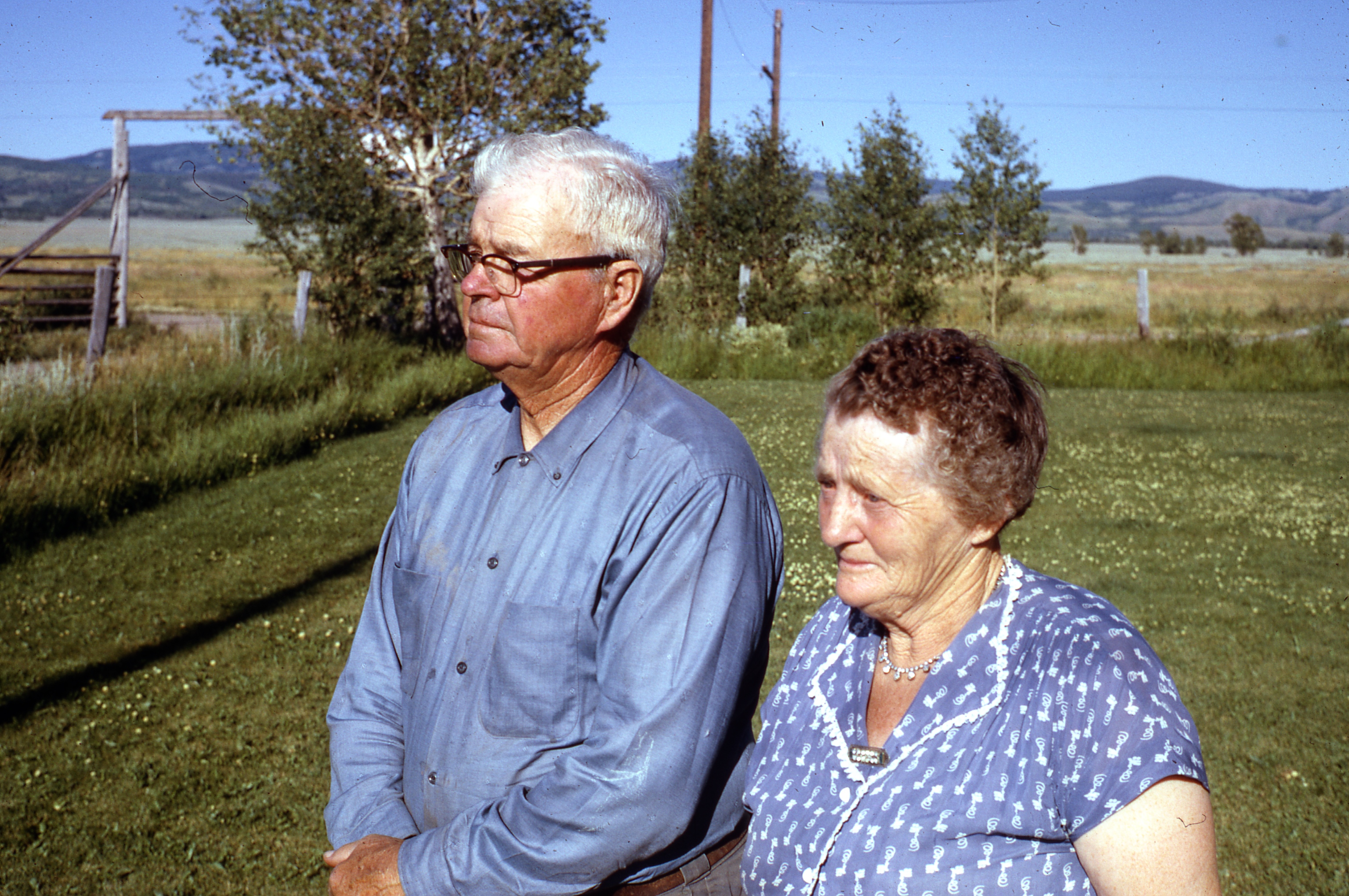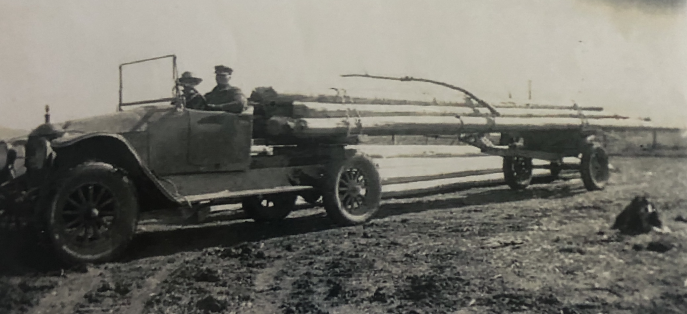Built 1934-1935
As told by Boyd Moulton to Vern T May in May of 2005
 Life on the frontier of Jackson Hole, Wyoming was hard. Earlier settlers and homesteaders sustained life by the efforts of their own labor and existed because of their on ingenuity and tenacity. On July 1st, 1908, President Theodore Roosevelt Issued an executive order abolishing the Yellowstone National Forest and expanding the Teton National Forest. This Executive order opened lands in the valley previously closed to homesteading. In September of 1908, brothers, John Alfred, T Alma and J. Wallace Moulton located homesteads northeast of Blacktail Butte, after the release of the land from the forest reserve.
Life on the frontier of Jackson Hole, Wyoming was hard. Earlier settlers and homesteaders sustained life by the efforts of their own labor and existed because of their on ingenuity and tenacity. On July 1st, 1908, President Theodore Roosevelt Issued an executive order abolishing the Yellowstone National Forest and expanding the Teton National Forest. This Executive order opened lands in the valley previously closed to homesteading. In September of 1908, brothers, John Alfred, T Alma and J. Wallace Moulton located homesteads northeast of Blacktail Butte, after the release of the land from the forest reserve.
John Moulton “proved up” on the homestead and immediately began to build the buildings and fences and till the ground. He succeeded in getting all of the bare necessities in place by 1930. However he still lacked the barn that he had longed dreamed of.
Economic conditions in the United States in the 1930’s were grim and money was scarce to the point of being nearly non-existent on Mormon Row, located in Jackson Hole, Wyoming. The John Moulton family was particularly hard hit that year. John had suffered a ruptured appendix late in the summer of 1030 and had nearly died. A long recovery had left John weakened and unable to do his part in the struggle to sustain life on the homestead. The long dreamed of barn was still a dream, and there was no money.
Bartha Elizabeth Blanchard Moulton, wife of John Alfred, was not a women to let little things get in her way. In fact, Bartha did not let anything get in her way. The next improvement to the homestead needed to be a barn. Barns were central to the economic sustenance of the ranch. A barn was needed to house the horses that provided the horsepower to tame and till the soil and harvest the crops. A barn was needed to shelter the milk cows that provide much of the basic diet needs of the family, including milk, cream and butter. A barn was needed to keep the hay dry and available to feed the animals. The John Moulton family needed this barn and the little things like a national depression, debilitating sickness, nor lack of money would stand in the way of Bartha.
So in typical Bartha mode, she simply went to work. One of the hallmarks of Bartha was you made due with what you had. The family had milk cows, and milk cows provided milk. The typical use of the milk was to separate the milk from the cream, and then churn the cream into butter and sell the butter. These were the days before pasteurization was developed to extent the shelf life of fresh milk. However, there was another resource available to Bartha, one that had not been thought of by anyone else.
There was a National Park, Grand Teton National Park established in 1929. and in spite of the countries economic conditions, there were rich people who came to enjoy the spectacular scenery. There was a CCC (Civilian Conservation Corp) Camo near by and the workers there did not have fresh milk. The CCC was an invention or Franklin Roosevelt’s New Deal response to the Great Depression. The program provided meaningful work to men who had no work. Bartha would provide them and the dudes fresh milk to drink.
So the cows were milked and the milk transported to the park and CCC camp. Bartha would walk among the campsites call out “fresh milk”. For a dime the thirsty customers could purchase a quart of fresh milk and every dime was one step closer to a new barn.
Another problem to be solved was that of getting materials to build the barn. Timber Island was named for the beautiful stands of lodgepole pine that grew there. Timber Island is and artifact of geology in Jackson Hole. It is a strip of land protruding from the floor of the valley running parallel to the Teton mountains some 9 miles distance from the Moulton homestead. The lodgepole pines on the “Island” grew straight and tall. However, logs the size and length to build the dreamed barn were heavy and hard to haul. The 18 mile round trip was more than a day’s work for a team and wagon. Another approach was needed.
The Federal Government operated in those days much the same as they do now. The best equipment was used by the park service to maintain the park and, on regular intervals, this equipment was replaced. An upcoming auction was announced where trucks from Yellowstone National Park would be sold to the public at the nearby by headquarters of Grand Teton National Park. At the auction, John and Bartha bought a truck. The truck was manufactured by White trucks and it was painted yellow by the park service. It was about the size of modern 1 ton trucks. It did not have dual wheels and had a metal bed mounted behind the cab of the truck. No records exist at to the cost of this 10 year old truck. John and Bartha’s son Boyd estimated that is was purchased for less than $100. By today’s standards that is an inexpensive truck, but it took a lot of milk in 1933 to buy a truck.
You can’t haul 35 foot long logs in the bed of a 1 -ton truck. This was not a barrier to John and Bartha, rather another problem to be solved. A mechanical resource resided just down the road at the homestead of Henrie May. Clifford (Tip) Wood, nephew of Hadden May who was the wife of Henrie May, was helping Henrie put up hay. Tip was extremely mechanically gifted and provided the ingenuity and skills to transform the truck into the equivalent of today’s semi-trucks. The bed of the truck was removed and replaced with a homemade equivalent of what we know today as a 5th wheel. A bunker was improvised to sit atop the 5th wheel. The rear part of another junked truck was used as the axel to mount the rear bunker and ths axel hooked to the truck. Transportation for the logs

was now available. This photo shows John Moulton at the wheel of the truck with a load of barn logs. Note the ingenious manner in the logs were secured to the trailer with a pole and chain.
First the logs had to be cut, trimmed and peeled. Murland May, son of Henrie May who lived 2 miles south of Mormon Row was available for hire and during the spring and summer of 1934, he was hired to do the job. Boyd estimates that the 21 year old Murland made $1.00 per day for his efforts. Murland, who was an ingenious man, invented a method of pealing logs. He took an ordinary garden how and straightened it out. Then he sharpened the hoe to a razor edge. He the used the hoe as a spud, pushing the length of the log and removing the bark from the trees.